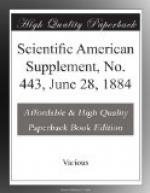4. If the ratio falls below 3.6, stearic acid or resin has been used as the adulterant.
* * * * *
PHENOL IN THE STEM, LEAVES, AND CONES OF PINUS SYLVESTRIS.
A discovery bearing on the flora of the carboniferous epoch and the formation of petroleum.
By A.B. Griffiths, Ph.D., F.C.S. Membre de la Societe Chimique de Paris, Medallist in Chemistry and Botany, etc.
Having found, in small quantities, alcohols of the C_{n}H_{2n-7} series, last summer, in the stem, acicular leaves, and cones of Pinus sylvestris, I wish in this paper to say a few words on the subject.
First of all, I took a number of cones, cut them up into small pieces, and placed them in a large glass beaker, then nearly filled it with distilled water, and heated to about 80 deg. C., keeping the decoction at this temperature for about half an hour, I occasionally stirred with a glass rod, and then allowed it to cool, and filtered. This filtrate was then evaporated nearly to dryness, when a small quantity of six-sided prisms crystallized out, which subsequently were found to be the hydrate of phenol (C_{6}H_{5}Ho)_{2}H_{2}O. Its melting point was found to be 17.2 deg. C. Further, the crystals already referred to were dissolved in ether, and then allowed to evaporate, when long colorless needles were obtained, which, on being placed in a dry test tube and the tube placed in a water bath kept at 42 deg. C., were found to melt; and on making a careful combustion analysis of these crystals, the following composition was obtained:
Carbon 76.6
Hydrogen 6.4
Oxygen 17.0
-----
100.0
This gives C_{6}H_{6}O, which is the formula for phenol.
On dissolving some of these crystals in water (excess) and adding ferric chloride, a beautiful violet color was imparted to the solution. To another aqueous solution of the crystals was added bromine water, and a white precipitate was obtained, consisting of tribromophenol. An aqueous solution of the crystals immediately coagulated albumen.
All these reactions show that the phenol occurs in the free state in the cones of this plant. In the same manner I treated the acicular leaves, and portions of the stem separately, both being previously cut up into small pieces, and from both I obtained phenol.
I have ascertained the relative amount of phenol in each part of the plant operated upon; by heating the stem with water at 80 deg. C., and filtering, and repeating this operation until the aqueous filtrate gave no violet color with ferric chloride and no white precipitate with bromine water.
I found various quantities according to the age of the stem. The older portions yielding as much as 0.1021 per cent, while the young portions only gave 0.0654 per cent. The leaves yielding according to their age, 0.0936 and 0.0315 per cent.; and the cones also gave varying amounts, according to their maturity, the amounts varying between 0.0774 and 0.0293.




